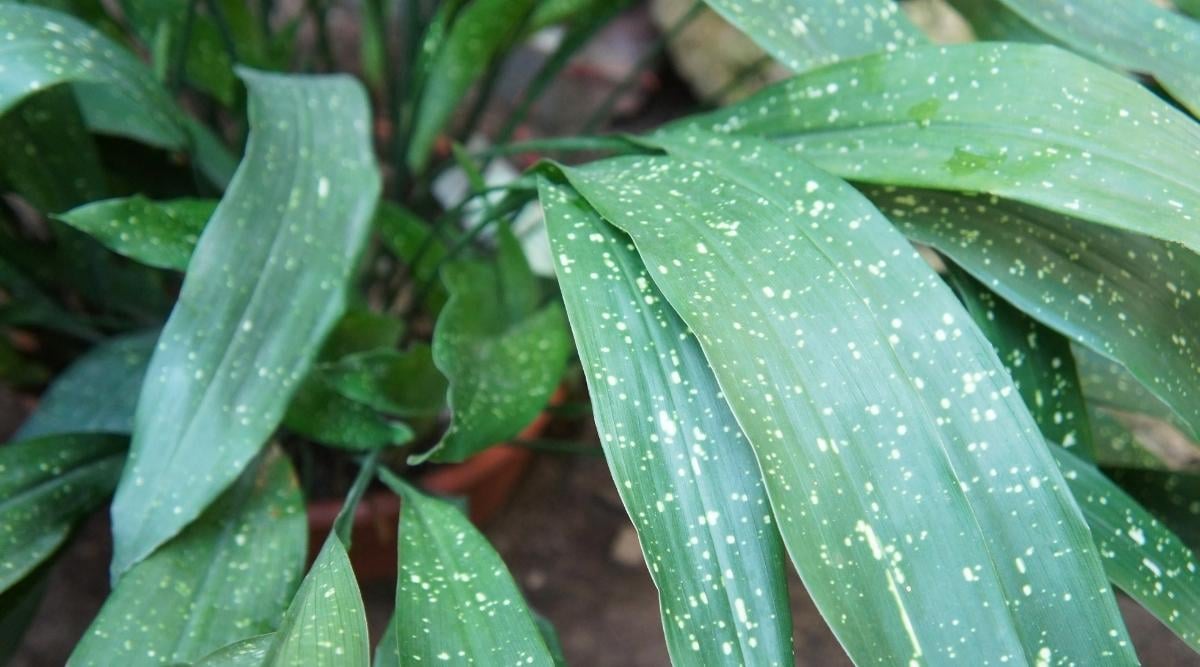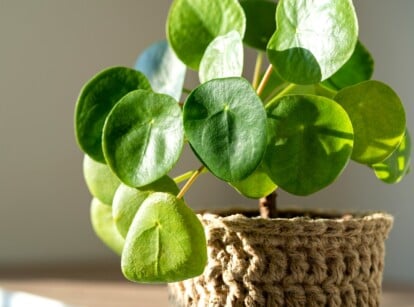19 Big-Leaf Houseplants to Make a Statement Indoors
Looking for a new houseplant, but want to make sure it has large leaves to compliment other plants in your indoor garden? If so, then you've come to the right place! In this article, we take a deeper look at our favorite big-leafed plants that can thrive in just about any indoor space!

Contents
Houseplants with big leaves make an eye-catching statement in any room. Their stunning foliage is an excellent and affordable way to spruce up your space and give you that at-home jungle feel you’ve been craving.
They can also be complementary to other indoor plants, providing a leafy green base, while using smaller plants like African violets or peace lilies to provide an additional pop of color.
If you’ve decided you want a houseplant with big leaves, there are plenty of different options to choose from. Whether you’re an avid houseplant collector or simply looking to add a little pizazz to a dark corner, these majestic plants will do the trick. Let’s take a look at our favorite houseplants with large leaves!
African Mask Plant

Few houseplants are as striking as the African mask plant. It is a smaller plant with big leaves that are shaped like a heart with wavy edges. Each waxy leaf has thick white veining and a purple underside.
It can be difficult to grow an African mask plant indoors, although you are rewarded with a truly beautiful plant if you succeed. It’s important to provide humid conditions and keep it out of direct sunlight to avoid burning the leaves.
African mask plants prefer lightly moist soil at all times. Therefore, planting in a container with well-drained soil is a must.
Banana Tree

A pet-friendly houseplant with big leaves is the banana tree. This tropical plant makes for a stunning addition to your home decor, thanks to its large yellow-green, paddle-shaped leaves and tall trunk. At maturity, each leaf can grow up to 10 inches long. Each plant produces between 8 to 12 leaves.
The banana tree requires humid conditions and moist, well-drained, acidic soil.
Birds of Paradise

One of the most beloved houseplants with big leaves is the bird of paradise. It is a tropical plant that produces gorgeous orange and blue flowers that have the appearance of feathered wings in flight. These flowers typically show up on the outer edges of the plant and will only appear if the plant receives full sun.
The bird of paradise has large, dark-green leaves that can reach up to 18 inches long and 6 inches wide. The leaves are thick, spreading out in layers from the central stalk. On average, this indoor plant will produce one new leaf each month.
If you want to grow a bird of paradise in your home, you’ll need to provide dense, acidic, well-drained soil and a suitable pot size.
Caladium

Caladium is a houseplant with big leaves that can add a delightful pop of color to any room. They have large, arrowhead-shaped foliage that comes in various colors, mainly pink, white, red, and green. Each leaf is a riot of color, as though they had been individually hand-painted. Many of their leaves come in variegated red patterns.
Caladium requires high humidity and stable temperatures. You should keep it away from drafty windows, vents, or air conditioning units. They typically do well in an area that is at least 65°F (18°C). Keeping a caladium in your bathroom or a sunroom is a great way to ensure it has the conditions it needs to thrive.
If you find yourself struggling to give your caladium the humidity it needs, you may want to consider using a humidifier.
Calathea Orbifolia

Calathea orbifolia is a calathea variety known for its large, rounded leaves that have pale, whitish-green stripes. The underside of the foliage is a silvery-green color.
There are dozens of calathea varieties. They are commonly referred to as prayer plants for the way their foliage rises and falls with the sun. These tropical plants originated from Brazil, and require high humidity to avoid brown tips.
Cast-Iron Plant

The cast-iron plant is a beloved houseplant that’s nearly impossible to kill. It thrives on neglect and can survive low light conditions. It also produces big leaves with a deep green color that can each reach up to 2 feet long.
Cast-iron plants are perfect for beginners or those with a notoriously brown thumb. In addition to being easy to care for, they are also resistant to many common pests and diseases.
Dumb Cane

The dumb cane plant is a big-leaf houseplant that can reach incredible heights indoors. It has showy, variegated leaves shaped like pointed paddles.
Dumb cane plants are ideal for beginners. They can easily survive a bit of neglect and don’t mind dark corners and low-light conditions. They also don’t have a soil preference.
Dumb cane plants are toxic to humans and pets.
Dwarf Cavendish Banana Tree

Another popular banana plant cultivar is the dwarf cavendish banana plant, so named due to the shorter stalk. It produces big leaves that start purple and turn green as they mature. When given the right conditions, this plant will produce edible fruit, although this is rare indoors.
This plant likes acidic, loamy, well-drained soil and should be fertilized regularly when grown indoors.
Elephant Ear

Elephant ear plants get their name from their large, arrowhead-shaped leaves. There are numerous varieties to choose from, each with slight variations in leaf shape and color. Most have a blue-green color.
Elephant ears can grow quite tall but are easy to grow and maintain. They are commonly grown outdoors but do well in pots indoors. Elephant ears don’t require much attention once they become established, although they are big eaters and drinkers. They also prefer well-drained soil, particularly when grown in a container.
It is important to keep in mind that these plants are toxic to animals if ingested.
Fiddle Leaf Fig

If buying a houseplant with big leaves is on your to-do list, you can’t go wrong with the popular fiddle leaf fig. This tree has green, waxy leaves that have a fiddle-like shape to them.
Fiddle leaf figs are notoriously temperamental and require a patient and experienced hand. They originate from the rainforest and prefer high heat and high humidity to thrive. That can be difficult for the average plant owner to achieve in their home.
Common troubles fiddle leaf fig tree owners experience are discoloration and leaf drops due to unsatisfactory environmental conditions. It is best to keep them away from vents and air conditioning units to avoid subjecting them to extreme temperature fluctuations.
When grown indoors in a container, fiddle leaf fig trees require frequent pruning. They need rich, well-drained soil as well.
Kentia Palm

Kentia palm is a no-fuss big-leaf houseplant that is easy to grow. They are drought-tolerant and produce arching, palm-shaped fronds in a deep green color. They are a great addition to a sunny corner to give a room a feeling of old-world elegance.
Kentia palms are also adaptable to their environments. They don’t have extreme soil preferences and can tolerate a wide range of light conditions. It should be kept away from direct light to avoid burning the leaves.
Common issues with kentia palms include pests like spider mites and mealybugs, as well as potassium deficiencies.
Leopard Plant

Leopard plants produce large leaves that look beautiful in an indoor container. This plant is a member of the sunflower family. When given the right conditions the leopard plant produces stunning yellow flowers that pollinators adore. They are not common indoor plants, but they can grow well in pots in indoor environments.
Some varieties produce bright yellow spots on their leaves, giving the plant its name. They aren’t picky about soil type, but they require consistent and even watering to avoid wilt and leaf drop. They also require higher temperatures and should be kept away from drafty windows or air conditioning vents.
Majesty Palm

No list of houseplants with big leaves would be complete without mentioning the majesty palm. This gorgeous tropical plant is one of many popular indoor palm trees. Majesty palms produce hundreds of delicate green fronds. It makes a wonderful statement in any well-lit corner.
Majesty palms grow roughly one foot per year, reaching maximum heights of six feet. They require moist, well-drained, acidic soil when grown in containers. They also prefer high humidity and temperatures between 65 to 85°F (18-29°C).
Rubber Tree

Also known as the rubber plant, the rubber tree is a beautiful houseplant with big attractive leaves. Its foliage is thick, waxy, and glossy. Each oblong leaf can grow up to 15 inches long.
You should repot your rubber tree plants at least once every 12 months to give them the space and nutrients they need to thrive indoors. These plants are hardy and can withstand plenty of neglect, even indoors.
Ruffled Fan Palm

The ruffled fan palm has incredible, heart-shaped foliage with pleats that resemble a paper fan. The edges of these big leaves are sharp, and certain areas of the palm contain spines. However, once mature, the leaves grow up to 22 inches wide, erupting from a single trunk.
Their unique appearance makes them a popular houseplant, however, it can be difficult to acquire one. They are also coveted by plant owners who need pet-safe options in their homes.
Snake Plant

The snake plant is a popular houseplant with big leaves because it is easy to take care of. The plant consists of stiff, upward-facing leaves shaped like swords. They range in color, but common varieties have a dark green center and a yellow or white border.
Snake plants are tropical plants that do well in low-light conditions. This makes them a great addition to hallways and basements.
Monstera

Monsteras are a fan favorite in the big-leaf houseplant community. Their large, showy green leaves have a heart shape and easily identifiable leaf splits called fenestrations. When given proper support, they can grow like a vine.
It is important to provide monsteras with proper drainage in both its soil and its container. There’s nothing this plant hates more than waterlogged roots. It also requires consistent light and warm temperatures, although too much direct sun can burn the leaves. Mist the plant regularly to help it maintain the proper humidity.
Velvet Philodendron

The velvet philodendron is a rare, creeping philodendron variety native to Colombia. Its yellow-green heart-shaped leaves are gigantic. They have beautiful pink, pale green, or cream-colored veins that cut across each leaf.
Velvet philodendrons prefer humidity between 60-80% and should be misted often if you can’t achieve those levels in your home. The plant is a slow grower and produces one new leaf a month.
Xanadu

Xanadu produces some of the boldest and most attractive foliage. Each leaf can reach up to 16 inches in length and features spiky, lobed edges. The entire plant grows upwards, and unlike most philodendrons, it’s not vining. It is a compact plant that is usually wider than it is tall.









